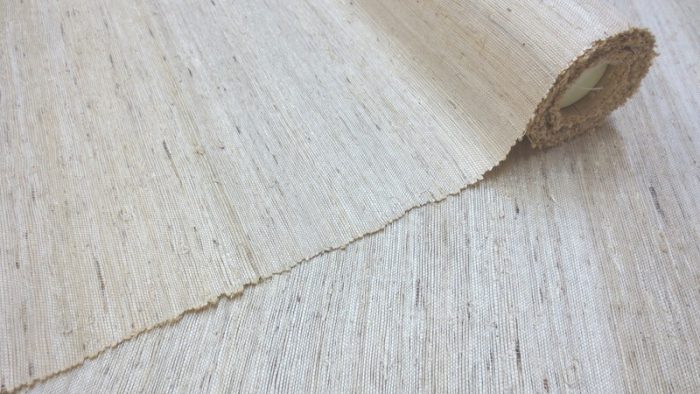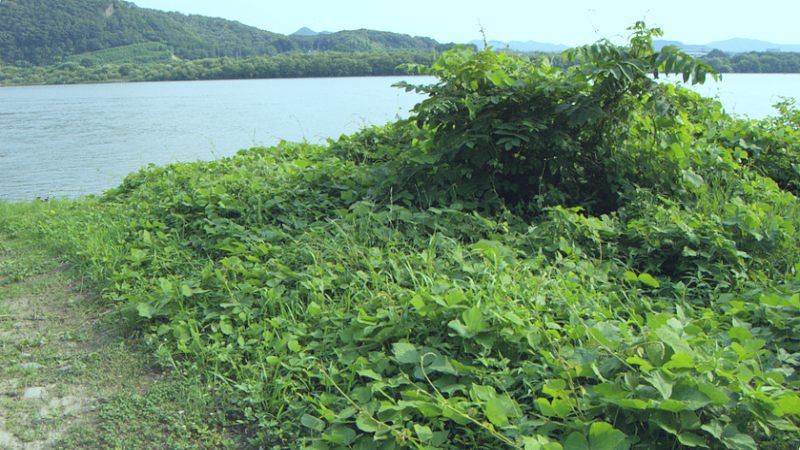The Hirota Tsumugi Blog
- 2019.03.02
- An ancient Japanese textile, Kudzu cloth

Kudzu (otherwise known as East Asian arrowroot) is a kind of vine plants native to much of Asia, primarily originated from Japan, China or Korea. “Kudzu” is derived from the Japanese name, and in Japan, China, or Korea, it has been used for food, tea, or medicine and even deeply ingrained in the cultural aspects.
In Japan, it grows wild anywhere the mountains, even reproduce at the barrens. Due to its reproductive power, on the other hand, Kudzu is globally known as notorious, introduced invasive plant.
Especially in the United States, its introduction from Japan from the end of 19th century for gardening, livestock feed, fertilizer, or soil erosion control, resulted in the devastating environmental result. Its spreading speed is out of control especially in the South, and the cost to spraying and mowing reaches several million dollar annually.
Kudzu is a vine plant that grows around 10 meters long, that are climbing, coiling and trailing. Among them, trailing kudzu that grows wild is chose and gathered. Kudzu-fu, or Kudzu cloth is made of the bast-fiber threads by removing its barks and cores.

Kudzu grow wild on the river bed. Trailing kudzu with few burls is suitable for making the textile
In Japan, the textiles made of kudzu fibers had been produced from the prehistoric time, along with other ancient bast-fiber textiles including Shina-fu, or Basho-fu. In terms of gathering, Kudzu fu is easier compared with shina-fu and Basho-fu ; Collecting of shina trees requires going into dangerous deep mountains, and harvesting and management of Itobasho (a kind of bananas) requires about 3 years. Therefore, Kudzu fiber textiles had been produced pretty much everywhere in the Japanese islands, although Kakegawa region, at Shizuoka prefecture, is the only producing area of Kuzdu-fu today.
Although it is relatively easier to collect, likewise the other ancient textiles, inordinate amount of time is required for making a yarn. In order to make 200 gram of the fibers (for a bolt of textile), more than 10 kg of Kudzu is necessary.
Collecting of Kuzdu is done while summer period between the beginning of Jun to the end of September. The leaves are removed and the stems are boiled and then exposed in river water. these materials are then moved into the fermentation process, which are unique method unlike other Japanese bast-fiber textiles of debarking bast-fibers. On the soil, weed and grass bed is prepared and the kudzu is placed on it, furthermore, covered by the weed and grass. After 2 or 3 days, the fermentation occurs and the barks becomes slippery and easy to debark.
The soften stems are washed in river water to remove the barks and the hard cores. After that, the yarns are put into bran water in order to plus luster with its oil. Finally, white inner barks are split up by nails into thin fibers and becomes a kudzu yarn.
Kudzu-fu has the shine, which other bast-fiber textiles, cotton or hemp do not have, and is different from the luster of silk.

This is the about 30 cm wide kudzu textile, made for obi (kimono belt). The wrap yarns are silk, and the weft yarns are Kudzu yarns. In the past, both wrap and weft yarns are used for making a Kudzu textile. Yet, from the Edo period, using the wrap for silk, cotton or hemp becomes common. The luster kuzdu-fu produces is something significant that cannot be expressed even by spun gold or silver.
